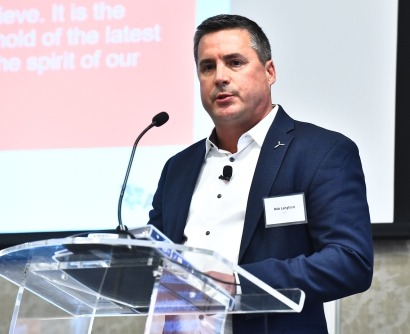
However, there remains much to be optimistic about as we enter 2025. Everywhere we look we see human ingenuity, resilient global economic growth and transformative digital and AI technologies. Importantly, there’s real momentum behind renewable energy and clean energy tech, which is breaking through cost barriers to deliver the kind of meaningful impact the decarbonization effort needs.
Our aspirations for the year ahead include:
Collaboration: exploring the untapped potential of cross-industry cooperation
When we look at the offshore energy sector holistically, it’s clear there are a lot of synergies between oil and gas and offshore wind. Too often, however, these opportunities to collaborate and co-operate are missed, and the two industries can instead be at odds, competing for equipment and supply chain capacity, driving up costs for both. There are huge efficiencies to be gained through better collaboration and co-creation of assets, such as multi-purpose vessels that can support both industries and reduce downtime for shipowners.
People power: building a sustainable workforce
Renewable energy is booming, and it needs people if it is to fulfil its potential as laid out in net zero pathways. We hope 2025 is the year when we see increased cross-training of personnel from the power and offshore energy sectors in order to bring their expertise and knowhow into the growing renewable energy industries, so we can build sustainable and rewarding jobs for the long term.
Green electricity everywhere: accelerating decarbonization
As we’re midway through the decade of decarbonization, it’s time to really pick up the pace. The offshore wind resource is vast and can be harnessed to electrify far more than we do today, from powering existing oil and gas production plants, feeding charging stations both on and offshore for all manner of vessels and vehicles, to unlocking clean generation of hydrogen or ammonia to creating next-generation fuels for hard-to-abate transport and industrial sectors.
Turbocharging digital: AI and innovation at the forefront
Digital technology is unlocking efficiencies across the industry, and the gap between the digital frontrunners and the laggards is really going to widen in the coming years as AI applications gain traction, both shoreside and at sea. We hope 2025 is the year that the offshore renewables industries embrace digital twins, virtual replicas of ships or processes.
Using real-time data from sensors and devices along with AI-powered modelling to simulate different scenarios, digital twins allow companies to analyze and predict the behavior and performance of the physical counterpart to anticipate future outcomes, troubleshoot potential issues to inform predictive maintenance, and optimize performance without interfering with the actual system.
We also hope that 2025 will be a breakthrough year for AI and machine learning technologies to improve LCOE (Levelized Cost of Energy) of existing and emerging energy generation technologies, whether that’s improving grid integration, optimizing the placement of wind turbines or reducing capital costs by optimizing supply chain management.
Marine Renewables: unlocking the ocean's potential
In 2025, we’re hoping to see continued policy and investment support for a global expansion of offshore renewables, not just wind and floating wind, but also floating solar, tidal stream, wave energy and even ocean thermal energy conversion (OTEC), a technology that generates electricity by harnessing the temperature difference between the ocean's surface and deep water. There’s so much potential to harness the power of the ocean to provide abundant clean energy, but it needs clear policy to unlock investor support for innovative technologies.
Infrastructure: a foundation for a clean energy future
The energy transition, both the integration of new renewable generation and the optimization of existing energy systems, requires a massive build out of new infrastructure. From new grid capacity to the electrification of ports, there’s significant potential to not only do more with what we already have but also to integrate cleaner energy sources in a more efficient and streamlined way.
A new administration: policy and investment for offshore growth
We’re optimistic that a new administration in the White House will provide ongoing support for investment in offshore industries, including streamlined permitting and collaborative partnerships between industry and regulators. The US economy feeds off a thriving energy system, whether it’s smart stewardship of the nation’s oil and gas reserves, leveraging the experience and ingenuity of our pioneering offshore sector, or providing the right framework of subsidies and grants to foster innovation in next generation fuels and clean energy tech. Get this mix right, and we have a chance to lead the world in how to innovate for a cleaner and more prosperous future.
Our role in the year ahead
At ABS, we’re excited to share and play our part. This year we’ll be continuing to support new Technology Reviews and Approval in Principles for the vessels and floating structures that keep the fast-growing offshore renewable energy industry afloat. Electrification is clearly key to a Net Zero future, which is why we’re producing new standards to support the renewable energy business, from requirements for the High Voltage Cables (HVDC/AC) for offshore wind and electrification to technical guidance for fast-emerging offshore solar projects.
We see the value of digital technology and AI to transform the pace of the energy transition, which is why we’re collaborating with partners across sectors to find smarter ways to decarbonize faster, and embracing Digital Twins, the Internet of Things and AI to find solutions that can make a material impact in meaningful timescales.
And we practice what we preach: we’re embedding sustainability into all our projects because it’s not just the right thing to do, it’s also good for business.
About the Author: Rob Langford is the Vice President of Global Offshore Renewables at ABS, bringing over 30 years of extensive experience in offshore consulting, engineering, construction, installation, operations and maintenance.

